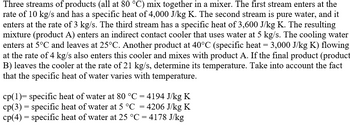
Introduction to Chemical Engineering Thermodynamics
8th Edition
ISBN: 9781259696527
Author: J.M. Smith Termodinamica en ingenieria quimica, Hendrick C Van Ness, Michael Abbott, Mark Swihart
Publisher: McGraw-Hill Education
expand_more
expand_more
format_list_bulleted
Question
Please include your diagram, mass balances, and full work. Thank you.

Transcribed Image Text:Three streams of products (all at 80 °C) mix together in a mixer. The first stream enters at the
rate of 10 kg/s and has a specific heat of 4,000 J/kg K. The second stream is pure water, and it
enters at the rate of 3 kg/s. The third stream has a specific heat of 3,600 J/kg K. The resulting
mixture (product A) enters an indirect contact cooler that uses water at 5 kg/s. The cooling water
enters at 5°C and leaves at 25°C. Another product at 40°C (specific heat = 3,000 J/kg K) flowing
at the rate of 4 kg/s also enters this cooler and mixes with product A. If the final product (product
B) leaves the cooler at the rate of 21 kg/s, determine its temperature. Take into account the fact
that the specific heat of water varies with temperature.
cp(1)= specific heat of water at 80 °C = 4194 J/kg K
cp(3) = specific heat of water at 5 °C = 4206 J/kg K
cp(4) = specific heat of water at 25 °C = 4178 J/kg
Expert Solution
This question has been solved!
Explore an expertly crafted, step-by-step solution for a thorough understanding of key concepts.
Step by stepSolved in 5 steps with 29 images

Knowledge Booster
Similar questions
- Packed columns were rarely used for distillation unless column diameter was less than 2.5 ft. Explain why, in recent years, some trayed towers are being retrofitted with packing and some new large-diameter columns are being designed for packing rather than trays.arrow_forwardWhat are centrifugal pumps?arrow_forwardDistillation is an essential operation used commonly for the separation of materials in process engineering. Explain clearly how relative volatility can influence separation process by distillationarrow_forward
- Q1 .Stress apply on polymer sample has 10 cm length, 1 cm width and 2 mm thickness that operates at a constant strain and the elastic modulus is 340000 Psi. The stress drops to 0.850 of the initial stress afther 6 mounts. Calculate the following: a- The initial stress on the sample? b- The elastic modulus afther 12 months?arrow_forwardDerivation of the general equation for interpolation: develop from scratch the equation interpolation you need to developarrow_forwardDescribe the similarities and differences between the Lewis method and the Rigorous method.arrow_forward
- Explain the setting time of concretearrow_forwardDefine Accuracy and give two examples of how this can be expressed. Define Hysteresis.arrow_forwardAluminum is not as strong as steel. What other factor needs to be considered when comparing the desirability of aluminum versus steel if strength is an important consideration for a design?arrow_forward
arrow_back_ios
SEE MORE QUESTIONS
arrow_forward_ios
Recommended textbooks for you
 Introduction to Chemical Engineering Thermodynami...Chemical EngineeringISBN:9781259696527Author:J.M. Smith Termodinamica en ingenieria quimica, Hendrick C Van Ness, Michael Abbott, Mark SwihartPublisher:McGraw-Hill Education
Introduction to Chemical Engineering Thermodynami...Chemical EngineeringISBN:9781259696527Author:J.M. Smith Termodinamica en ingenieria quimica, Hendrick C Van Ness, Michael Abbott, Mark SwihartPublisher:McGraw-Hill Education Elementary Principles of Chemical Processes, Bind...Chemical EngineeringISBN:9781118431221Author:Richard M. Felder, Ronald W. Rousseau, Lisa G. BullardPublisher:WILEY
Elementary Principles of Chemical Processes, Bind...Chemical EngineeringISBN:9781118431221Author:Richard M. Felder, Ronald W. Rousseau, Lisa G. BullardPublisher:WILEY Elements of Chemical Reaction Engineering (5th Ed...Chemical EngineeringISBN:9780133887518Author:H. Scott FoglerPublisher:Prentice Hall
Elements of Chemical Reaction Engineering (5th Ed...Chemical EngineeringISBN:9780133887518Author:H. Scott FoglerPublisher:Prentice Hall
 Industrial Plastics: Theory and ApplicationsChemical EngineeringISBN:9781285061238Author:Lokensgard, ErikPublisher:Delmar Cengage Learning
Industrial Plastics: Theory and ApplicationsChemical EngineeringISBN:9781285061238Author:Lokensgard, ErikPublisher:Delmar Cengage Learning Unit Operations of Chemical EngineeringChemical EngineeringISBN:9780072848236Author:Warren McCabe, Julian C. Smith, Peter HarriottPublisher:McGraw-Hill Companies, The
Unit Operations of Chemical EngineeringChemical EngineeringISBN:9780072848236Author:Warren McCabe, Julian C. Smith, Peter HarriottPublisher:McGraw-Hill Companies, The

Introduction to Chemical Engineering Thermodynami...
Chemical Engineering
ISBN:9781259696527
Author:J.M. Smith Termodinamica en ingenieria quimica, Hendrick C Van Ness, Michael Abbott, Mark Swihart
Publisher:McGraw-Hill Education

Elementary Principles of Chemical Processes, Bind...
Chemical Engineering
ISBN:9781118431221
Author:Richard M. Felder, Ronald W. Rousseau, Lisa G. Bullard
Publisher:WILEY

Elements of Chemical Reaction Engineering (5th Ed...
Chemical Engineering
ISBN:9780133887518
Author:H. Scott Fogler
Publisher:Prentice Hall


Industrial Plastics: Theory and Applications
Chemical Engineering
ISBN:9781285061238
Author:Lokensgard, Erik
Publisher:Delmar Cengage Learning

Unit Operations of Chemical Engineering
Chemical Engineering
ISBN:9780072848236
Author:Warren McCabe, Julian C. Smith, Peter Harriott
Publisher:McGraw-Hill Companies, The